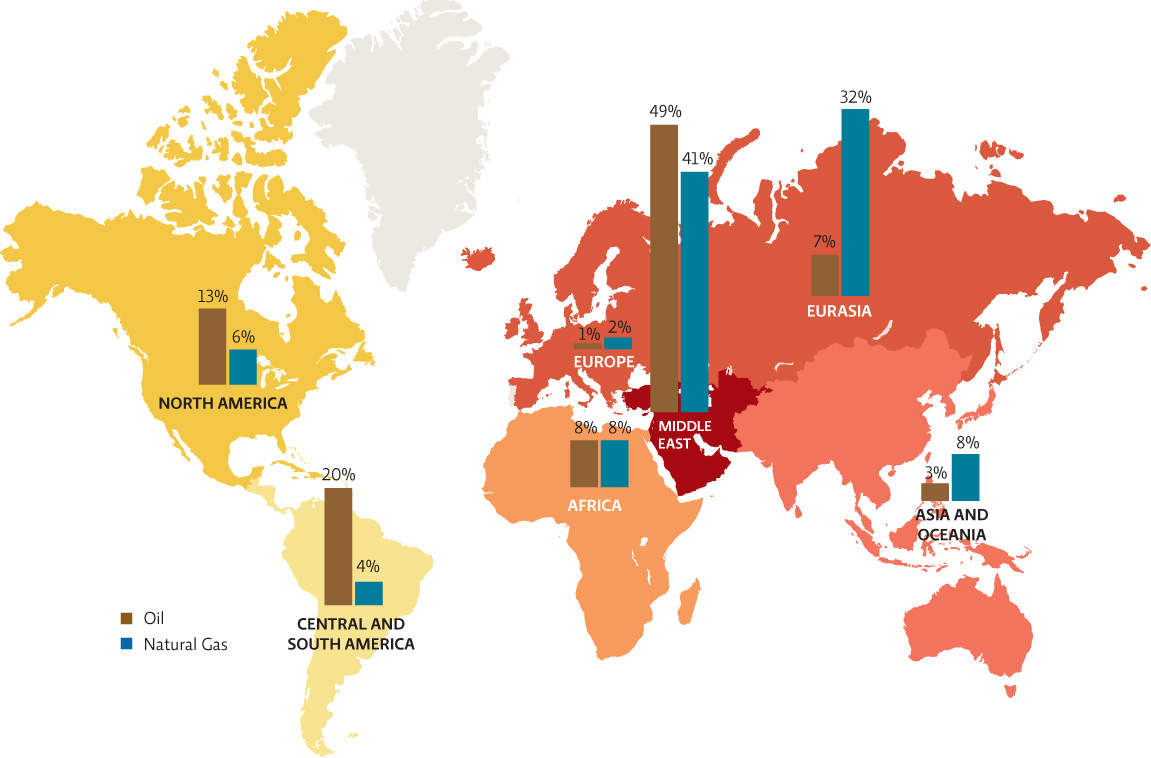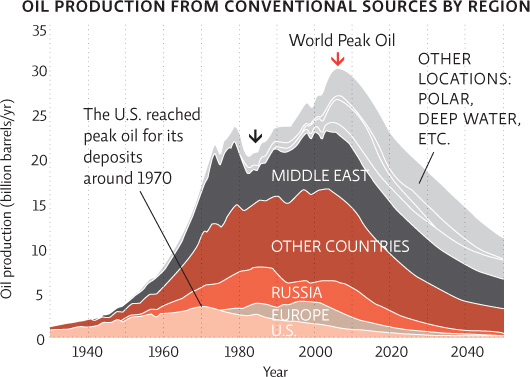Oil is a limited resource.
Oil is a liquid fossil fuel made up of hundreds of types of hydrocarbons, organic compounds of hydrogen and carbon. Hydrocarbons take many forms—solid, liquid, or gas— and we have developed methods for extracting them from the depths of Earth. Oil is found some 0.3 to 9 kilometers (0.2 to 5.5 miles) below the surface, where rigs have to dig deep in order to reach it. At that depth, it does not exist in thick black pools. Instead, if you could look down into an oil reservoir, you’d see rock. Crude oil is found as tiny droplets wedged within the microscopic open spaces, or pores, inside rocks.
crude oil
A mix of hydrocarbons that exists as a liquid underground; can be refined to produce fuels or other products.
Oil deposits are found in various regions around the world. Proven reserves are the amount of a fuel that is economically feasible to extract from a deposit using current technology. Conventional oil reserves hold crude oil that can be extracted with traditional oil wells. Such reserves are not evenly distributed around the planet, leading to political problems among countries that have the oil, like those in the Middle East, and those that do not have enough to meet their own needs, like the United States. At current rates of extraction and use, known reserves are expected to last another 40 to 50 years, though this number is uncertain because reports of oil reserves tend to be questionable. (Many nations keep their reserves estimates secret.)
proven reserves
A measure of the amount of a fossil fuel that is economically feasible to extract from a known deposit using current technology.
conventional oil reserves
Light-or medium-density crude oil deposits; extracted by pumping.
Natural gas reserves are also finite. The Middle East has the most conventional reserves of natural gas, with about 41% of the world’s reserves; the United States has only 6%. Total world conventional reserves of natural gas are expected to last 60 to 100 years at current rates of use. But as with oil, natural gas use is increasing at about 2% per year. At this rate, natural gas could run out much sooner if new supplies, or methods to access currently inaccessible supplies, are not found. INFOGRAPHIC 19.2
Different regions of the world have different amounts of oil and natural gas reserves. Here we show the proven reserves by region as a percentage of the world total. (Geographic areas are shown in different colors to more easily distinguish each region.)


In 2013 there were 1,646 billion barrels (bbl) of oil in proven world oil reserves. How many bbl were in North America?
214 bbl (13% of 1,646 or 0.13 x 1,646)
KEY CONCEPT 19.2
The largest conventional oil reserves are in the Middle East. We have likely passed peak oil for conventional reserves; production has peaked and will decline over time.
World demand for oil rises more than 2% each year, and because conventional oil reserves are finite, it is possible that we have already passed peak oil, the moment in time when oil reaches its highest production levels before it steadily and terminally declines. Some say peak oil occurred in 2002, others in 2006, and others still that it won’t be reached until 2020. In any case, once we’re past peak oil, the demand will outstrip the supply, and this will have international economic repercussions. Most economists agree that the days of cheap oil are gone. The sooner we prepare for a world with less oil, the easier the transition to a different energy economy will be. INFOGRAPHIC 19.3
peak oil
The moment in time when oil reaches its highest production levels and then steadily and terminally declines.
Peak oil represents the point in time when oil reaches its highest production levels and then steadily and terminally declines. It is likely that the world has reached, or will soon reach, peak oil for conventional reserves (red arrow). The dip (black arrow) seen in the early 1980s represents an oil glut; conservation efforts during the oil crisis of the 1970s led to reduced demand, but we have since resumed an upward course of oil consumption.


How much oil did Russia produce in 1990? (Hint: It was not 7.5 billion barrels; see Appendix 2 for pointers on reading area graphs.)
Russia produced approximately 4 billion barrels of oil in 1990 (this is the width of the “ribbon” for Russia at that time point).
Weaning ourselves off fossil fuels will not be easy. Populations in developed and developing countries alike are utterly dependent on fossil fuels. And the problems that oil, natural gas, and coal bring are significant and increasing. Unfortunately, there are no easy answers to the question of how best to power our societies. Every energy option at our disposal (see Chapters 18—23 and LaunchPad Chapter 32) comes with advantages and disadvantages, and no single energy source can easily replace fossil fuels. This is what makes meeting our energy needs a wicked problem.
New unconventional reserves of oil and natural gas, such as those that can be extracted using fracking technology, may increase supplies in the short term but will not extend them indefinitely. They are, however, changing the global oil and natural gas market as more and more is being produced in the United States.
unconventional reserves
Deposits of oil or natural gas that cannot be recovered with traditional oil/gas wells but may be recoverable using alternative techniques.